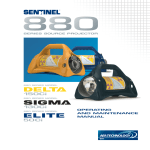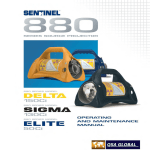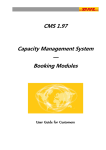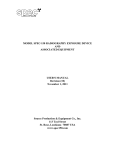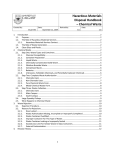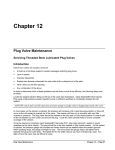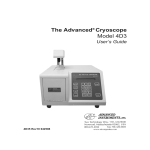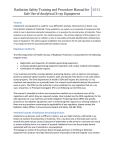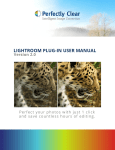Download MODEL SPEC 2-T USER`S MANUAL
Transcript
MODEL SPEC 2-T Radiography Exposure Device and Associated Equipment USER’S MANUAL Revision (1) July 25, 1997 SOURCE PRODUCTION & EQUIPMENT CO., INC. 113 Teal Street, St. Rose, LA 70087 PHONE 504-464-9471 FAX 504-467-7685 EMAIL [email protected] WEB www.spec150.com TABLE OF CONTENTS 1.0 OPERATING PROCEDURES ................................................................................................................................ 4 1.1 PROCEDURES FOR PREPARING AND LOADING THE PACKAGE .................................................... 4 1.1.1 PACKAGE PREPARATION............................................................................................................. 4 1.1.2 TRANSPORT..................................................................................................................................... 8 1.2 PROCEDURES FOR RECEIPT AND UNLOADING THE PACKAGE .................................................... 9 1.2.1 HANDLING AND UNLOADING..................................................................................................... 9 1.2.2 RECEIVING THE SPEC 2-T........................................................................................................... 10 1.3 PREPARATION OF AN EMPTY PACKAGE FOR TRANSPORT.......................................................... 11 1.3.1 LIMITED QUANTITY OF RADIOACTIVE MATERIAL............................................................. 11 1.3.2 LABELED RADIOACTIVE MATERIAL SHIPMENT.................................................................. 12 2.0 1.4 GENERAL DESCRIPTION ....................................................................................................................... 14 1.5 SPECIFICATIONS ..................................................................................................................................... 14 1.6 SAFETY ..................................................................................................................................................... 14 1.7 OPERATING PROCEDURES ................................................................................................................... 14 ACCEPTANCE TESTS AND MAINTENANCE PROGRAM ........................................................................... 16 2.1 ACCEPTANCE TESTS (PRIOR TO FIRST USE) .................................................................................... 16 2.1.1 VISUAL INSPECTION ................................................................................................................... 16 2.1.2 STRUCTURAL AND PRESSURE TESTS ..................................................................................... 16 2.1.3 LEAK TESTS................................................................................................................................... 16 2.1.4 COMPONENT TESTS .................................................................................................................... 16 2.1.5 TESTS FOR SHIELDING INTEGRITY ......................................................................................... 16 2.1.6 THERMAL ACCEPTANCE TESTS ............................................................................................... 17 2.2 MAINTENANCE PROGRAMS................................................................................................................. 17 2.2.1 STRUCTURAL AND PRESSURE TESTS ..................................................................................... 17 2.2.2 LEAK TESTS................................................................................................................................... 17 2.2.3 SUBSYSTEMS MAINTENANCE .................................................................................................. 17 2.2.4 VALVES, RUPTURE DISCS AND GASKETS ON CONTAINMENT VESSEL ......................... 17 W:\SALES\MANUALS\2T\2TOPMAN1.DOC -2- Revision (1) July 25, 1997 2.2.5 SHIELDING .................................................................................................................................... 17 2.2.6 THERMAL....................................................................................................................................... 18 2.27 MISCELLANEOUS......................................................................................................................... 18 2.3 SAFETY INSPECTION AND MAINTENANCE PROCEDURES ........................................................... 18 APPENDIX ............................................................................................................................................................................ 21 W:\SALES\MANUALS\2T\2TOPMAN1.DOC -3- Revision (1) July 25, 1997 Source Production and Equipment Company, Incorporated 113 Teal Street, Street Rose, Louisiana 70087 July 25, 1997 The Certificate of Compliance for Radioactive Material Packages No. 9056 issued by the U. S. Nuclear Regulatory Commission for the SPEC 2-T requires that the device be prepared for shipment and operated in accordance with the Operating Procedures of Section 7.0 of the Type B(U) application as supplemented. The Certificate also requires that the package meet the Acceptance Test and Maintenance Program of Section 8.0 of the Type B(U) application as supplemented. Sections 7.0 and 8.0 as supplemented are reprinted here to allow the users of the SPEC 2-T to comply with the requirements of the Certificate of Compliance. 1.0 OPERATING PROCEDURES 1.1 Procedures for Preparing and Loading the Package Training of personnel who prepare and offer hazardous material shipments, including the SPEC 2-T, for transport is required pursuant to 49 CFR 173.1(b) and training of personnel transporting hazardous materials on public highways, including a SPEC 2-T loaded with Iridium-192, is required pursuant to 49 CFR 177.800(a). The source assembly is initially loaded into the SPEC 2-T at the SPEC facilities under the provisions of Louisiana Radioactive Material License LA-2966-L01 in accordance with the procedures and radiation protection standards established under that license. Users of the SPEC 2-T may be authorized to install the specified source assemblies in the SPEC 2-T in accordance with the provisions of their agreement state or NRC radioactive material license and in accordance with the instructions of the source exchanger authorized in their specific radioactive material license. As an example, the SPEC C-1 source changer is authorized for use with source assemblies used in the SPEC 2-T exposure device. The SPEC 2-T should be prepared for shipment by an employee pursuant to the above requirements and may be a radiographer, radiation safety officer or similarly qualified employee of the licensee. A properly prepared package may be loaded onto a vehicle and transported by an individual who has been properly instructed pursuant too in the handling and transport of hazardous materials and who has been specifically instructed in securing radioactive material packages from movement during transport, separation distances, maximum transport index limitations and placarding requirements. 1.1.1 Package Preparation 1. Package Registration The shipper, including users who transport the SPEC 2-T as a private carrier, must register as a user of the package by writing to: Transportation Branch, Division of Safeguards and Transportation, U. S. Nuclear Regulatory Commission, Washington, D.C. 20555 W:\SALES\MANUALS\2T\2TOPMAN1.DOC -4- Revision (1) July 25, 1997 2. General Package Inspection Visually inspect the SPEC 2-T to determine if it is in unimpaired condition for shipment. The SPEC 2-T should be inspected to determine that it is not damaged, that the lock operates properly, that the source assembly (pigtail) is securely locked in the package, and that the safety plug and lock cap are securely positioned. Verify that the package identification plate is present and legible, which identifies the package as a SPEC 2-T and displays the package identification number USA/9056/B(U). If any of the following required information is not present or legible the shipper may durably mark the required information on the SPEC 2-T package provided that he has determined that the package was fabricated in accordance with the approved design. RADIOACTIVE MATERIAL, SPECIAL FORM, N.O.S., UN2974 USA/9056/B(U) TYPE B Model SPEC 2-T MAXIMUM GROSS WEIGHT: 49 POUNDS Contains Approximately 35 Pounds of Depleted Uranium, Source Production and Equipment Company, Incorporated, St. Rose, Louisiana. 3. Packaging Verify that the lock plunger is fully depressed, and that the source assembly is properly locked and secured in the SPEC 2-T. The source safety plug and the lock cap must be firmly attached. Although the SPEC 2-T package may be shipped and transported as a separate package it is recommended that it be placed in a convenience overpack for transportation by the user as a private carrier and for shipment by a common carrier. If surface radiation levels exceed 200 mrem/hr then a convenience overpack is required for shipment on a nonexclusive use basis. Convenience overpacks are provided which consist of a 12-gallon steel drum and molded foam packing material, which prevents the movement of the SPEC 2-T within the barrel. Secure the top to the drum with the locking ring and tighten the locking ring bolt or secure the ring clamp. Although the SPEC 2-T lock functions as a security seal, it is recommended that a lead or other shipping security seal be affixed to the locking ring on the barrel. Any outer packaging maybe used as a convenience overpack if it meets the general packaging standards (49CFR173.24). Shielding may be incorporated into the convenience overpack to achieve any desired radiation levels for transportation. 4. Outer Package Surface Contamination Regulations require that the non fixed (removable) contamination on the external surfaces of the outer package being shipped on a nonexclusive use basis not exceed 10-4 uC1/cm2 (4Bq/cm2 or 220 dpm/cm2) averaged over 300 cm2 of any part of the surface. This may be determined by measuring the activity on wipes taken from representative locations and the above criteria is assumed to be met if the activity on any sample averaged over the surface area wiped does not exceed 10-5 uC1/cm2 (0.4Bq/cm2 or 22 dpm/cm2). If the contamination on the surface W:\SALES\MANUALS\2T\2TOPMAN1.DOC -5- Revision (1) July 25, 1997 of the outer package exceeds the above amount or if the source is known to be leaking or contaminated DO NOT SHIP, but contact Source Production and Equipment Company, Incorporated for assistance. 5. Markings When a SPEC 2-T is shipped or transported without a convenience overpack the required markings as described above must be placed on the SPEC 2-T. When a SPEC 2-T is shipped or transported in a convenience overpack the outer package must be marked: RADIOACTIVE MATERIAL, SPECIAL FORM, N.O.S. UN2974 INSIDE PACKAGE COMPLIES WITH PRESCRIBED SPECIFICATION. The convenience overpack must also be marked with the name and address of the consignee or consignor unless it is an exclusive use or private carrier shipment. 6. Labels No internal labels. Survey the package and determine the maximum radiation levels at the surface and at one meter (39.37 inches) from the surface. Transport Index (TI) is the dimensionless number equivalent to the maximum radiation level measured in mR/hr (10 uSv/hr) at one meter (39.37 inches) from the surface of the package. Select the proper label from the chart below such that the specified radiation levels are not exceeded: Radioactive Label Radioactive White I Radioactive Yellow II Radioactive Yellow III Surface mR/hr 0.5 50 200 Transport Index TI Not Applicable 1.0 10.0 Complete the information on two labels: Contents: Iridium-192 or Ir-192 Activity: Determine the activity in Curies (Ci) or terabecquarel (Tbq) by calculation from the original activity or from the decay chart T.I.: Enter the appropriate measured value rounded up to the next tenth. Apply two radioactive labels to opposite sides of the outer package in such a manner that they do not obscure the required markings. The old radioactive labels must be removed or the new labels applied on top of the old labels. When a convenience overpack is used additional labels on the inside package are not necessary. U.S. regulations prohibit this package on any passenger carrying aircraft entering U.S. airspace and on U.S. flag carriers anywhere. Most other countries and airlines will permit this shipment on passenger carrying aircraft. Before entry into U.S. airspace by any carrier or before offering to a U.S. flag carrier one CARGO AIRCRAFT ONLY label must be affixed so that it does not obscure the radioactive labels or required markings. W:\SALES\MANUALS\2T\2TOPMAN1.DOC -6- Revision (1) July 25, 1997 7. Shipping Papers U.S. Department of Transportation Hazardous Material Regulations requires the following shipping paper information when shipping or transporting the SPEC 2-T packages: Radioactive Material, Special Form, N.O.S., UN2974 Iridium192 ____ C1 Radioactive white I, Yellow II or Yellow III Label USA/9056/B(U) Cargo Aircraft Only (if offered for air transportation). For water transportation only enter the number of SPEC 2-T s that is being transported by a private carrier. Shipper s Certification: Not required for private carriers. This is to certify that the above named materials are properly classified, described, packaged, marked, labeled and are in proper condition for transportation according to the applicable regulations of the Department of Transportation. For air transportation only add: This shipment is within the limitation prescribed for passenger aircraft/cargo aircraft only (delete nonapplicable). Signatures are required for the above certification statements. The signature must be legibly signed by a principal, officer, partner or employee of the shipper or his agent. It may be legibly signed manually, by typewriter, or other mechanical means. Although the U.S. Department of Transportation or the ICAO Technical Instructions does not require a specified form for shipping papers or dangerous goods transport documents most international airlines are a member of the International Air Transport Association and require use of the IATA Shipper s Declaration for Dangerous Goods candy-stripe form. Therefore, it is recommended that you use this form for international shipments to avoid possible delays. Consult the current edition of the IATA Dangerous Goods Regulations or Source Production and Equipment Company, Incorporated for assistance in completing the IATA Shipper s Declaration for Dangerous Goods and other international shipping requirements. 8. Type B Quantity Consignee Notification Prior to each shipment of a SPEC 2-T containing more than 20 C1 Iridium-192 the shipper will notify the consignee of the dates of shipment and expected arrival. 9. Records and Documentation The shipper, including users who transport the SPEC 2-T as a private carrier, is required to have a current copy of the NRC Certificate of Compliance No. 9056 in their possession and comply with the provisions in the certificate for shipment. U.S. Department of Transportation Hazardous Material Regulations requires that the shipper maintain on file for one year after the last shipment documentation of any test, demonstrating that special form material requirements have been met. A copy of the IAEA Certificate of Competent Authority USA/0095/S may be used to satisfy this requirement. The NRC and most agreement state regulations require that the following records be W:\SALES\MANUALS\2T\2TOPMAN1.DOC -7- Revision (1) July 25, 1997 maintained for at least two years after each shipment: 1) Identification of packaging by its model number: SPEC 2-T 2) Verification that the package was in satisfactory condition when shipped 3) Activity of Iridium-192 in each shipment 4) Date of each shipment, note that this includes transport by a user of the SPEC 2-T as a private carrier 5) Address to which shipment was made 6) Results that the package was properly prepared for shipment and evidence that surface contamination limits were met. In addition NRC licensees are required to maintain for the life of the SPEC 2-T package quality assurance records which establish the continuing integrity and safety of the package. 1.1.2 Transport 1. Placarding When transporting one or more packages with a Radioactive Yellow III label four RADIOACTIVE placards must be displayed on the front, rear and two sides of the motor vehicle so that it is readily visible from the direction it faces and so that the wording is horizontal. The placard must be at least three inches away from any markings on the vehicle and must be securely affixed. When offering a package with a Radioactive Yellow III label to a motor carrier for transport the shipper must offer to provide the motor carrier four RADIOACTIVE placards unless the vehicle is already displaying four RADIOACTIVE placards. The motor carrier does not have to accept the placards, and it is recommended that the shipper indicate on the bill of loading that placards were offered and acknowledged by the signature o the motor carrier driver on the bill of loading. 2. Shipping Paper Accessibility A carrier, including a private carrier transporting a SPEC 2-T for his own use, is required to have the required shipping paper readily available to and recognizable by authorities in the event of an inspection or an accident. The shipping paper must be clearly distinguished from other papers by having it on top or distinctively tabbing it. When the driver is at the vehicle controls, while he is restrained by a seat belt, the shipping paper must be stored within his immediate reach, and readily visible to an individual entering the driver s compartment or in a holder mounted inside on the driver s door. When the driver is in the vehicle, the shipping paper must be in a holder mount inside of the driver s door or on the driver s seat. 3. Secure from Movement Radioactive material packages must be blocked and braced so they cannot change positions within the vehicle under conditions ordinarily encountered in transportation. W:\SALES\MANUALS\2T\2TOPMAN1.DOC -8- Revision (1) July 25, 1997 4. Separation Distances The U.S. Department of Transportation Hazardous Material Regulations requires that the following distances must be maintained from the closest radioactive material package to any area occupied by an individual: Total Transport Index 0.1 - 1.0 1.1 - 5.0 5.1 - 10.0 Separation Distance Feet 1 2 3 The above separation distances do not apply within the outer package exceeds 200 mrem/hr at the surface of the package or the T.I. is greater than 10.0, and when the package is being transported under exclusive use conditions. Although the above separation distances are specified by the U.S. Department of Transportation, each user should check their license application to determine if they are committed to a maximum of 2 urem/hr or some other radiation level in any occupied area of the vehicle. 5. Route Selection The U.S. Department of Transportation Hazardous Material Regulations requires that when transporting one or more Radioactive Yellow III package that the vehicle is operated on routes that minimize radiological risk [See 49 CFR 117.825(a) for details]. 6. Other Requirements A carrier, including a private carrier, transporting at least one Radioactive Yellow III labeled package is subject to the Federal Motor Carrier Safety Requirements, 49 CFR Parts 390-397, pertaining to such items as driver qualifications, driving of motor vehicles, hours of service, vehicle inspections and maintenance, and specific precautions with hazardous materials, including radioactive materials. 1.2 Procedures for Receipt and Unloading the Package 1.2.1 Handling and Unloading The SPEC 2-T, either as the outside package or in a convenience overpack, may be handled during transport and unloaded as an ordinary package by hand. No special equipment or procedures are required. The consignee must establish written procedures for receiving and safely opening the SPEC 2-T outside the package. The procedures should provide for inspection, monitoring, notification and records. W:\SALES\MANUALS\2T\2TOPMAN1.DOC -9- Revision (1) July 25, 1997 1.2.2 Receiving the SPEC 2-T 1. Delivery, Pick Up and Acceptance from Carrier Regulations require that the consignee must make arrangements to receive the SPEC 2-T when it is offered for delivery by the carrier; or must make arrangements to receive notification from the carrier at the time of arrival for pick up at the carriers facility. When the SPEC 2-T is offered for delivery by a carrier, it must be received by the consignee. The consignee must expeditiously pick up the SPEC 2-T upon receipt of notification from the carrier. The package must be accepted by the consignee even if there is a damage claim against the carrier. A damage claim should be noted on the bill of loading and acknowledged by signature of a representative of the delivering carrier. 2. Receipt Survey and Inspection Before the delivered package is opened and as soon as practicable after receiving the SPEC 2-T, but no later than three hours after it is received at the consignee s facility during normal working hours or eighteen hours if received after normal working hours the package must be monitored and inspected. The outside package, as received, should be inspected for any indication of damage to the SPEC 2-T, and the maximum external radiation levels at the surface of the outside package and at one meter from the surface of the outside package must be measured and recorded. Dents and abrasions to the overpack normally encountered in handling, loading and unloading are not generally considered evidence of damage to the SPEC 2-T. Since the sealed source in the SPEC 2-T is classified as special form, radioactive material, it is not required to monitor the external surfaces of the outside package for removable contamination. 3. Notification If the measured maximum radiation levels at the surface of the outside package and at one meter from the surface of the outside package exceed either of the following limits: Location Surface of Outside Package One Meter from Surface of Outside Package Maximum mrem/hr 200 10 Then the consignee must immediately notify the final delivering carrier, and either the agreement state radiation control agency, if applicable, or the NRC regional office having jurisdiction over the location where the package was received. It is also recommended that the shipper be notified. Care should be exercised in performing the survey that the radiation levels are measured at the proper distances, that the survey meter is calibrated and operating properly, and that the stated accuracy of the survey meter is considered. W:\SALES\MANUALS\2T\2TOPMAN1.DOC -10- Revision (1) July 25, 1997 4. Records Records of the receiving survey should be maintained for a period of three years which includes at least: date and time package received or picked up; date and time monitored; identification of the package by serial number; identification of the source by serial number, isotope and activity (includes the date of measurement); identification of individual performing the survey; identification of a survey meter by serial number; maximum radiation levels at the surface of an outside package and at one meter from the surface of an outside package; and corrective action and notification to carrier and regulatory agency, if applicable. 1.3 Preparation of an Empty Package for Transport When preparing an empty SPEC 2-T for transport, an inspection must be performed to verify that it does not contain a source assembly. Step 1: With the safety plug installed, remove the lock cap to verify that there is no connecting cable (pigtail) protruding from the lock end of the SPEC 2-T. If a pigtail connector is present, the package is not empty and cannot be offered for transport as an empty package. Note: If the SPEC 2-T contains a source assembly the source tag must be inspected to verify that the source model is authorized for use with the SPEC 2-T. Step 2: If a pigtail connector is not present, place the SPEC 2-T vertically upright with the lock end down. Survey the lock end of the SPEC 2-T on all four sides. If the radiation intensity exceeds 10 millirem per hour at the surface of the SPEC 2-T, it may contain a source assembly where the connecting cable (pigtail) has been removed or shortened. Immediately discontinue transport preparation, refer to Emergency Procedures, and notify the Radiation Safety Officer or Source Production and Equipment Company, Incorporated. Note: An empty SPEC 2-T will produce radiation levels up to approximately 4 millirem per hour at the surface due to the depleted uranium shielding. Step 3: If the radiation intensity exceeds 10 millirem per hour in Step 2 do not transport the SPEC 2-T until assured that it is empty. Verify by cranking the drive cable of a control assembly completely through the SPEC 2-T to remove any source assembly that may be inside. This should be performed by the Radiation Safety Officer. When the SPEC 2-T is shipped or transported without an Iridium-192 sealed source it should be prepared in one of the two methods as described below, since it contains depleted uranium and it is not an empty package. 1.3.1 Limited Quantity of Radioactive Material The SPEC 2-T can qualify as an excepted article containing depleted uranium pursuant 49 CFR 173.424, provided that the maximum radiation level on the external surface of the outside package does not exceed 0.5 mrem/hr at any point. Radiation levels on the surface of an empty SPEC 2-T exceed 0.5 mrem/hr, and therefore the SPEC 2-T as an outside package cannot qualify as an excepted article containing depleted uranium. The SPEC 2-T must be placed in an outside package, such as a 12-gallon drum convenience overpack, to reduce the radiation levels on the surface W:\SALES\MANUALS\2T\2TOPMAN1.DOC -11- Revision (1) July 25, 1997 of the outside package below 0.5 mrem/hr. A manufactured article containing depleted uranium is excepted from specification packaging, marking, labeling, shipping paper, and certification requirements pursuant to 49 CFR 173.424. Shippers should consult with Source Production and Equipment Company, Incorporated concerning variations in requirements for international shipment. 1. Packaging Install, if available, the source safety plug and lock cap in the SPEC 2-T. Verify that the SPEC 2-T identification plate is legible and present. If the identification plate is not presently marked with the SPEC 2-T RADIOACTIVE. Place the SPEC 2-T in a strong tight outside container, such as the 12-gallon drum convenience overpack in which it was received. Verify that the maximum radiation level on the surface of the outside package does not exceed 0.5 mrem/hr. 2. Labeling Labels are not required. Remove any RADIOACTIVE, White or Yellow labels, and any CARGO AIRCRAFT ONLY labels from the outside package. If the levels cannot be removed, they may be covered with an EMPTY label. 3. Marking Markings are not required. The proper shipping name marking, RADIOACTIVE MATERIAL, SPECIAL FORM, N.O.S. UN 2974, and INSIDE PACKAGE COMPLIES WITH PRESCRIBED SPECIFICATION and other markings may remain if at least one EMPTY label is affixed, since the EMPTY label negates the meaning of any markings. 4. Shipping Papers and Certification Shipping papers and certifications are not required for domestic shipments. The package may be returned by a mode of transport, including passenger aircraft. The following notice must be enclosed in or on the package, included with the packing list, or otherwise forwarded with the package: This package conforms to the conditions and limitations specified in 49 CFR 173.424 for excepted radioactive material, an article manufactured from depleted uranium, UN2909. It is recommended that the above notice be attached to the empty SPEC 2-T. 1.3.2 Labeled Radioactive Material Shipment A SPEC 2-T as the outside package without an Iridium-192 source may only be shipped or transported as a labeled radioactive material shipment. W:\SALES\MANUALS\2T\2TOPMAN1.DOC -12- Revision (1) July 25, 1997 1. Packaging The thirty-five pounds of depleted uranium according to the regulations may be shipped in a Type B package, and the SPEC 2-T qualifies as a Type B package. The SPEC 2-T should be inspected to determine that it is in unimpaired condition. The source tag should be removed from the SPEC 2-T. 2. Marking The proper shipping name and UN number, RADIOACTIVE MATERIAL, SPECIAL FORM, N.O.S., UN2974 should be covered over and changed to read RADIOACTIVE MATERIAL, N.O.S., N.O.S., UN2982. The USA/9056/B(U) TYPE B on the identification plate must be legible. The package must also be marked with the name and address of the consignee or consignor unless it is an exclusive use or private carrier shipment. 3. Labeling The radiation levels on the surface of the SPEC 2-T will not exceed 50 mrem and the transport index will not exceed 1.0, therefore affix two Radioactive Yellow II labels on opposite sides of the SPEC 2-T in such a way that they do not obscure the required marking above. Complete the information on two labels: Contents: Depleted Uranium or U (depleted) Activity: Determine the activity in Curies (Ci) or terabecquarel (TBq). Thirty-five pounds of depleted uranium is equivalent to approximately 7 mCi. T.I.: Enter the appropriate measured value rounded up to the next tenth. The TI should be 0.1. 4. Shipping Paper U. S. Department of Transportation Hazardous Material Regulations requires the following shipping paper information: Radioactive Material, N.O.S., UN2982 Depleted Uranium 7 mCi Metallic Solid Radioactive Yellow II Label USA/9056/B(U) Cargo Aircraft Only (If offered for air transportation). For water transportation, only enter the number of SPEC 2-T devices in each overpack, the number of overpacks; and the gross weight of each SPEC 2-T package (i.e.49 pounds) or the gross weight of each overpack. The following certification statements must be added to the above shipping paper information except when the SPEC 2-T is being transported by a private carrier. Shippers Certifications Not required for private carriers This is to certify that the above named materials are properly classified, described, packaged, marked, labeled and are in proper condition for transportation according to the applicable regulations of the Department of Transportation. For air transportation only add: This shipment is within the limitation prescribed for passenger aircraft/cargo aircraft only (delete nonapplicable). Signatures are required for the above certification statements. The signature must be legibly signed by a principal, officer, partner or employee of the shipper or his agent. It may be W:\SALES\MANUALS\2T\2TOPMAN1.DOC -13- Revision (1) July 25, 1997 legibly signed manually, by typewriter, or other mechanical means. Although the U.S. Department of Transportation nor the ICAO Technical Instructions does not require a specified form for shipping papers or dangerous goods transport documents most international airlines are members of the International Air Transport Association and require use of the IATA Shipper s Declaration for Dangerous Goods candy-stripe form. Therefore, it is recommended that you use this form for international shipments to avoid possible delays. Consult the current edition of the current edition of the IATA Dangerous Goods Regulations or Source Production and Equipment Company, Incorporated for assistance in completing the IATA Shipper s Declaration for Dangerous Goods and other international shipping requirements. 1.4 General Description The Spec 2-T exposure device is a remotely controlled uranium shielded radiography unit designed for use in the field as well as the laboratory. The basic composition of the unit is the light weight depleted uranium shield with its zircoloy "S" tube and a steel housing. The Spec 2-T is built for use under the most adverse conditions with virtually no maintenance. The Spec 2-T requires no external power source and its complete portability and light weight make field use by only one operator simple and efficient. 1.5 Specifications Total weight of the Spec 2-T is approximately 40 pounds and contains approximately 35 pounds of depleted uranium. The case is heavy gauge steel built to DOT specifications. The unit has been approved by all applicable regulatory agencies for use with an Iridium 192 source up to 200 curies. The source is controlled with a 25-foot mechanical control assembly. The assembly is extremely light weight and the flexible source guide tube used in this control assembly may be up to 23 feet long. The handle of the unit is designed to store the protector cap and safety plug when these items are not being used. This should eliminate losing these parts. 1.6 Safety The source is secured in the shielded position with a plunger-type keyed lock. Further security is provided by a lock cap and safety plug when the unit is not in use. The source cannot be withdrawn from the back of the unit even in the unlocked position. The rectangular shape of the unit makes it virtually impossible to "topple" over and enables the operator to place it in an extremely small or constricted area. 1.7 Operating Procedures 1. Before handling the Spec 2-T make sure you have an operable, calibrated survey meter and monitor every operation. W:\SALES\MANUALS\2T\2TOPMAN1.DOC -14- Revision (1) July 25, 1997 2. Remove the safety cap from the back of the unit (end nearest lock) exposing the pigtail connector. 3. Turn the crank on the control assembly in a clockwise direction to expose approximately eight inches of the drive cable. 4. Connect the drive cable to the source pigtail. 5. Crank the control assembly in a counter clockwise direction so that the swivel connector can be threaded into the back of the unit. Screw the male connecting thread all the way into the back of the unit. 6. Remove safety plug from the outlet on the front of the unit by retracting the quick disconnect coupling. 7. Connect the source tube snapping the quick disconnect coupling over the outlet nipple. 8. Check to see that the end piece is securely in place on the end of the source tube. Place the end of the source tube in the desired position while avoiding small radius bends and kinks. 9. Fully extend the controls from the unit avoiding as many turns and kinks as possible. 10. Unlock the unit using key provided. 11. To expose the source, turn crank handle clockwise. As source nears the end of the source tube, diminish turning speed to prevent the source from hitting the end piece with undue force. Count the number of crank turns so you will know when you are approaching the end of the tube. 12. Survey to determine if radiation levels are appropriate. 13. To retract the source after the exposure, turn the crank handle counter clockwise. 14. Survey to ascertain that the source is in the stored or safe position. 15. Lock the device by depressing the lock plunger. Jiggle the connector to be certain that the pigtail is firmly locked in position. 16. Unscrew the swivel connector and crank out approximately 8 inches of the drive cable. 17. Disconnect the drive cable from the source pigtail. 18. Replace safety cap over the source pigtail. 19. Disconnect the source tube and replace the safety plug. W:\SALES\MANUALS\2T\2TOPMAN1.DOC -15- Revision (1) July 25, 1997 2.0 ACCEPTANCE TESTS AND MAINTENANCE PROGRAM 2.1 Acceptance Tests (Prior to First Use) 2.1.1 Visual Inspection Upon receipt of a new SPEC 2-T the licensee should perform a general visual inspection of the package in accordance with the procedures and criteria approved pursuant to 10 CFR 34.28(b) or equivalent agreement state regulations. 2.1.2 Structural and Pressure Tests Structural acceptance tests on the SPEC 2-T are not indicated because of the rugged design and durable materials of construction any structural failure would be apparent. Pressure tests are not indicated because there is no possibility of a pressure build up which would affect the structure of the containment or the integrity of the package. In accordance with 10 CFR 71.85 nondestructive liquid penetrant inspection is utilized by the manufacturer as the final inspection method for the structural joints of the SPEC 2-T packaging fabricated in accordance with the Source Production and Equipment Company, Incorporated Thermal Metal Joining Procedures. Inspection procedures and inspection personnel qualification procedures are performed in accordance with Source Production and Equipment Company, Incorporated Liquid Penetrant Inspection Procedures. 2.1.3 Leak Tests Pursuant to licensing provisions a leak test is not required upon initial receipt if there is documentation that a leak test has been performed within six months prior to the transfer of the sealed source. If there is no such documentation then the licensee should perform a leak test in accordance with the provisions of his license prior to placing the radiography device in use. A leak test is not required upon receipt of special form material pursuant to 10 CFR 20.205(b)(1)(111) and equivalent agreement state regulations. 2.1.4 Component Tests Component acceptance tests on the SPEC 2-T are not indicated. Daily and quarterly inspection by the user pursuant to 10 CFR 34.28 and equivalent agreement state regulations are more than sufficient. 2.1.5 Tests for Shielding Integrity Upon receipt of the SPEC 2-T the licensee is required to survey the package prior to opening it pursuant to 10 CFR 20.205(c) or equivalent agreement state regulations. Upon initial receipt of the SPEC 2-T and whenever a source is exchanged, a survey should be performed to show compliance with 10 CFR 34.21 or equivalent agreement state regulations that the maximum radiation level at six inches from the W:\SALES\MANUALS\2T\2TOPMAN1.DOC -16- Revision (1) July 25, 1997 surface of the SPEC 2-T does not exceed 50 mrem/hr when the activity is extrapolated to 240 Ci of Iridium-192. 2.1.6 Thermal Acceptance Tests A thermal acceptance test for the SPEC 2-T is not indicated since heat of decay for the maximum permissible activity Iridium-192 source (240 Ci) is negligible. 2.2 Maintenance Programs 2.2.1 Structural and Pressure Tests Periodic structural acceptance tests on the SPEC 2-T are not indicated because of the rugged design and durable materials of construction any structural failure would be apparent. Periodic pressure tests are not indicated because there is no possibility of a pressure build up which would affect the structure of the containment or the integrity of the package. 2.2.2 Leak Tests Leak tests for removable contamination are required to be performed at least every six months on the sealed source pursuant to 10 CFR 34.25 or equivalent agreement state regulations. A leak test should also be performed whenever there is indication of damage to the sealed source capsule. The leak test sample should be taken by inserting at least a six-inch cotton tipped swab into the outlet nipple. If the tests indicate 0.005 micro curies or more of the removable contamination the sealed source must be removed from use, action taken to prevent the spread of contamination, and a report filed with the applicable radiation control agency within five days. It is also recommended that be notified. 2.2.3 Subsystems Maintenance The SPEC 2-T has no subsystems. 2.2.4 Valves, Rupture Discs, and Gaskets on Containment Vessel Not applicable since the primary containment vessel is a small sealed source capsule. 2.2.5 Shielding The daily and quarterly inspection programs performed by the licensee pursuant to 10 CFR 34.28 or equivalent agreement state regulations, and the daily surveys of the device performed pursuant to 10 CFR 34.43(b) or equivalent agreement state regulations are sufficient to establish the continuing integrity of the shield. W:\SALES\MANUALS\2T\2TOPMAN1.DOC -17- Revision (1) July 25, 1997 2.2.6 Thermal A periodic thermal test on the SPEC 2-T is not indicated since heat of decay for the maximum permissible activity Iridium-192 source (240 Ci) is negligible. There are no components which are thermally degraded by typical use and transport. 2.2.7 Miscellaneous The daily and quarterly inspection and maintenance programs require that all licensed users of the SPEC 2-T are more than sufficient to assure the continuing integrity of the package. 2.3 Safety Inspection and Maintenance Procedures Although the Spec 2-T radiography exposure device is designed for virtually maintenancefree operation, regulatory agencies usually require that a thorough inspection be performed at least every 90 days, or more frequent if the device appears to warrant it. Maintenance procedures for the exposure device are simple and can be performed in the field. Should a source require repair, however, return it to the manufacturer. Do NOT attempt source repair. A daily check list is affixed to the device for operator convenience. A complete inspection procedure follows: 1) Remove safety cap and inspect source connector. The holding pin should still have a true 90 degree elbow; it should be straight and parallel with the axis of source connector and the key on the apex of the elbow should not be worn excessively. Check flexible cable at connector for straightness. Maintenance: If the elbow is not bent out of line, the mating connector should then be connected to the source and tested by pulling straight back on cable applying about 30 to 40 pounds of pressure. If source connector is damaged, do not use. Return the unit to Source Production and Equipment Company, Incorporated. 2) The lock plunger should be inspected and checked for ease of operation. Foreign matter may at times foul the plunger and make it inoperative. The lock plunger may not retract to its fullest extent which is inch. This would prevent free travel of the source in and out of the device. Maintenance: The lock plunger may be removed by removing a set screw in the back of the unit. Wash lock in solvent to remove dirt or other foreign matter. Lock may also be cleaned and lubricated by spraying a lubricant (such as WD-40) into the lock. 3) Inspect the source outlet nipple by first removing safety plug. The outlet nipple should be round and smooth so that it will match with I.D. of the source tube. Maintenance: If the outlet nipple should be out-of-round it can sometimes be straightened or if the nipple has been broken by dropping the unit, it must be replaced. This replacement can be done in the field shop or returned to Source W:\SALES\MANUALS\2T\2TOPMAN1.DOC -18- Revision (1) July 25, 1997 4) 5) Production and Equipment Company, Incorporated. Inspect labeling on exposure device. The warning signs and source identification tags should be distinct and legible. Inspect source tubes for damage such as crimps, foreign matter, ease of connecting and disconnecting from exposure device. Maintenance: Crimps, kinks and other damaged places may be cut out and connectors placed on ends so that the tube is not shortened excessively. The quick disconnect coupling that connects to an outlet nipple of an exposure device may be removed and replaced. Foreign matter may be washed from the tube with solvent and blown with compressed air. 6) Inspect source connector on drive cable. The hole should be 7/64 inches in diameter when new. This hole should show some wear after much use, but should not be outof-round to the extent that it will disconnect from the mating piece other than in the correct position. It should not be loose on the drive cable. The portion of the connector with the connector hole should not be bent, but should be straight and parallel with body of the connector. Maintenance: This worn connector may be replaced by one of two methods. 7) A) Send back to Source Production and Equipment Company, Incorporated to have a new connector replaced by swaging on new replacement. B) Order a new core with a connector attached. Inspect remainder of drive cable for wear, rusty sections, causing cable to become stiff and non-flexing, kinks, or other damaging conditions that would prevent cable from running on gear in the gear box housing. Maintenance: The drive cable should be cleaned with a solvent such as varsol, diesel fuel or some other solvent that will not dry out. This is done to remove sand, dust and other foreign matter that will cause abrasions in the exposure device and gear box drive mechanism. Drive cable that has become rusty and non-flexible should be replaced. Failure to replace cable may cause controls to become stiff, hard to operate, wear excessively and possibly break. The cable would usually break when the source is exposed. Lubrication of the drive cable is important. In areas where there is a problem with sand or other abrasive material, dry powdered graphite is excellent. Graphite should not be packed continually since it will tend to pack in the gear box and cause excessive wear to the gear housing and to the gear. Where the control cables can be kept reasonably clean, a light oil will be adequate. 8) Inspect the control assembly. The bronze bushings (if used) in the gear housing and the plate are the most likely places to find wear. When these bushings are worn, they tend to permit the gear to wobble and eventually wear out. This normally will not W:\SALES\MANUALS\2T\2TOPMAN1.DOC -19- Revision (1) July 25, 1997 occur in control assemblies equipped with roller bearings. Usually (due to some build up on the drive cable or the gear teeth) there will be some wear around the inner circumference of the housing. This may permit the drive cable to slip on the gear and prevent the source from moving properly through the exposure device. Maintenance: It is suggested that if powdered graphite is used as a lubricant the gear box be cleaned with compressed air occasionally so as to remove any packed graphite in the gear mechanism. The application of some type light oil on the bronze bushings or bearings will help prevent excessive wear. If the inner circumference of the housing is severely worn, it should be replaced. 9) Inspect drive cable housing or conduit. This conduit can be damaged by dropping it across a hot weld, severe kinking, or by dropping some object on the conduit. Any of these can prevent the drive cable from moving freely. The conduit at the end connections may become damaged from excessive flexing while being assembled or disassembled. Maintenance: In any case where the inner liner has been damaged, the conduit must be replaced. When the outer covering has been damaged, waterproof tape should be wrapped around the break to prevent the entrance of water or other corrosive substances. If the extreme ends of the conduit are damaged, they should be returned to the manufacturer for repair. W:\SALES\MANUALS\2T\2TOPMAN1.DOC -20- Revision (1) July 25, 1997 APPENDIX W:\SALES\MANUALS\2T\2TOPMAN1.DOC -21- Revision (1) July 25, 1997





















